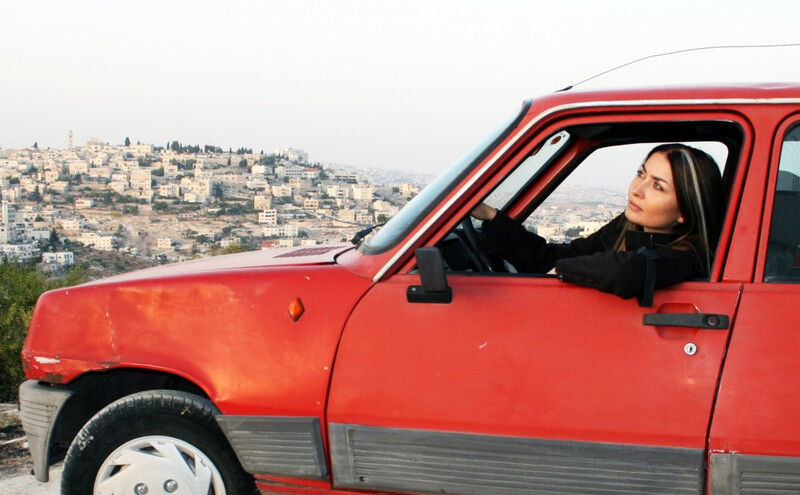The Electronic Intifada 11 December 2014
As a set of street interviews which accompany the closing credits of Open Bethlehem show, plenty of people in the modern West have no idea where or what Bethlehem is.
It represents just a name from the story of the birth of Christianity. Some are unsure whether it really exists or existed; if they do recognize it as a living city, they think it might be “in Africa” or — getting closer — “somewhere near Egypt.”
Leila Sansour’s film presents a highly personal portrait of her father’s native city and of her own love/hate relationship with it. It intertwines three narratives: that of Bethlehem as a historical city, of Sansour herself and that of the Open Bethlehem campaign, an effort to raise the profile of the city as it is encircled by Israel’s wall and literally dozens of settlements.
Filled with stories
Sansour herself was born in Moscow, the daughter of a Palestinian mathematics professor and his Russian wife. The family returned to Palestine in the early 1970s and stayed when her father became one of the founding faculty and later dean of the new Bethlehem University.
But Leila — whose childhood had been filled with stories of Bethlehem as a magical, wonderful place — hated the city. She left in her late teens, traveling the world in an apparent bid to escape her roots.
Family photographs and films are interwoven with more general footage and images of the history of Bethlehem — as a historical city invaded by countless armies, as a place of pilgrimage for, especially, Christianity and Judaism and as home to generations of people who watched the soldiers and visitors come and go.
Some of these historical images are amongst the most fascinating aspects of the film, including as they do rare scenes and insights into the fate that has befallen the city. Old engravings and photographs of Rachel’s Tomb, for instance, trace in sad detail its trajectory from a simple, dignified shrine on a quiet hillside, visited by Muslims, Christians and Jews alike, to a site accessible only to Jews and completely encased in Israeli military concrete.
This combination of the personal and political forms the backdrop to Sansour’s decision, during the second intifada, to return to Bethlehem to make a film about Israel’s wall.
Devastating
The footage she took in those early days includes devastating interviews with people like Khalil Musallam, who died, broken and bitter, soon after the wall cut him off from the businesses he’d spent forty years building up. Like Musallam, an aging farmer fights back tears as he looks over the remains of his seventy-year-old olive trees, cut by the Israeli army to clear a route for the wall.
“Security — they’ve swallowed the whole universe with this word,” says one bereft Bethlehemite.
Under the influence of these encounters, Sansour’s visit to her hometown morphed into a campaign, Open Bethlehem, launched in 2005 with the aim of raising awareness of the city and its slow strangulation by Israeli walls and settlements.
The tale of the Open Bethlehem campaign is intended, it seems, to be the backbone of the film and to provide its narrative drive. But in some senses this is the aspect which is least successful.

Leila Sansour in Open Bethlehem.
The story is skillfully told, with an almost brash, bombastic feel to the upward journey towards the campaign’s launch. We see Leila escorting journalists from major newspapers around Bethlehem, organizing high-profile campaign events in London and Washington, and the campaign team’s excitement at the arrival of the “Bethlehem passports” (imitation documents extolling the virtues of freedom and compassion, sent to celebrities, human rights figures and campaign supporters) which provided the focus of the campaign.
Alongside this we have a behind-the-scenes awareness of the tensions of donor demands and the surreality of talking about Israeli oppression from the opulent surroundings of Bethlehem’s Jacir Palace Hotel. And, eventually, the bombast turns sour, as the donors turn away from a campaign they regard as “political.”
Too niche?
It’s an affecting story, and one which gives some interesting insights into the challenges of communicating Palestinian issues to the mainstream press, with its minuscule attention span and deep-rooted amorality. But as the core of a film, it’s perhaps too niche a tale.
The focus on Sansour herself adds to this problem; we barely get a sense of who her colleagues are, except for her cousin Carole, the “anti-Leila” whose faithful adherence to Bethlehem is contrasted with Leila’s wanderings. Many speakers are never named, either in the voiceover or via captions, and events aren’t dated or contextualized.
While this works in terms of the personal narrative, it gives a sense of Open Bethlehem as a one-woman campaign, almost doomed to fail. The absence of background information on people and chronology — presumably intended to stop the film from feeling too much like a documentary — adds to the confusion. And the focus on Open Bethlehem’s tourism initiatives rather unfairly ignores the longstanding efforts of other Bethlehem-based organizations in this field.
But despite these drawbacks, Open Bethlehem is a moving film, delivering some valuable insights into the effects of the wall and settlements on this historical city — and more importantly, its people — and deepening their impact through some beautiful, and rarely-seen, footage of Bethlehem’s past.
With a December 2014 release in cinemas across the UK, this film should be essential holiday viewing. US audiences will have to wait until the festive season of 2015 for their chance to see Open Bethlehem on general release.
Sarah Irving is the author of a biography of Leila Khaled and of the Bradt Guide to Palestine and co-editor of A Bird is not a Stone, a collection of contemporary Palestinian poetry in translation. She is currently a PhD candidate at the University of Edinburgh.





